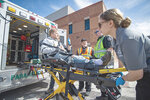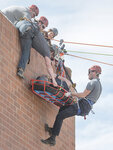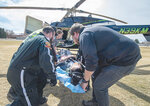Mostly Clear, 62° F
Members of the Northwest College Outdoor Education and Recreational Leadership program rushed to set up a twin-tension rope system in an attempt to save several shooting victims trapped on the roof …
This item is available in full to subscribers.
The Powell Tribune has expanded its online content. To continue reading, you will need to either log in to your subscriber account, or purchase a subscription.
If you are a current print subscriber, you can set up a free web account by clicking here.
If you already have a web account, but need to reset it, you can do so by clicking here.
If you would like to purchase a subscription click here.
Please log in to continue |
|





Members of the Northwest College Outdoor Education and Recreational Leadership program rushed to set up a twin-tension rope system in an attempt to save several shooting victims trapped on the roof of Ashley Hall. They were too late for one of the victims, fortunately just a mannequin.
The wounded were part of 32 student athletes, one mannequin and one instructor suffering from faux gunshot wounds and rushed to a makeshift triage center headquartered in the college’s Yellowstone Building. The mass casualty drill Tuesday was designed to overload local resources, teaching the students how to handle a similar situation. The triage was run by current nursing and emergency medical services students.
“Students had to come in and make decisions on who to treat first, who to transport first and who could wait,” said Steven Haggard, program director for EMS education at NWC. “They had to go through all the triage criteria we teach them in the classroom, and make decisions based on that. It helps reinforce what we've taught them in the classroom.”
As students were brought to triage, some were marked for treatment and others had a sheet pulled over their heads. Volleyball player Jo Anderson was “near death” and rushed by an ambulance supplied by Cody Regional Health to the soccer team’s practice field to be loaded into a First Flight of Wyoming helicopter. It was to be her first ever flight in a helicopter, but she said she wasn’t nervous once loaded in the aircraft while strapped to a specially designed stretcher.
Just prior to liftoff, as members of the First Flight team worked with students like Riverton’s Jesse Snyder to get Anderson secured, she learned she would be flown to Heart Mountain for a view of the iconic peak few have seen, rather than to a nearby hospital.
For Snyder, it was the culmination of his education prior to returning to Riverton and his job as an advanced emergency medical technician for Frontier Ambulance.
“I like to say I got lost on the way to the police academy,” Snyder said.
His primary goal was to serve his community in its times of need. He started as a volunteer firefighter but moved to the medical side of saving lives.
“At 18 years old, I volunteered with my local fire department. With every car accident and structure fire we were called to, I wondered if my skills were going to be enough. Several times I was left to comfort a patient and all I could say was, ‘Don’t worry. The paramedics will be here soon.’ It was frustrating wanting to help more but unable to do so,” he said while spotlighted by Frontier during EMS week. “I feel like I have found my calling. I no longer must tell a patient that help is on the way; I can tell them that help has arrived.”
Northwest College Nursing, EMS and Outdoor Education students worked with their professors and professionals from Powell Valley Healthcare and Cody Regional Health. Training as if it were real was important for all sides, Haggard said. To make it true to an actual mass shooting, he had the “victims” react as if they had been mortally wounded.
“I had them screaming to amp up that adrenaline. It was as close as we could get to realism,” he said. “I want them to experience that adrenaline rush and the confusion and chaos in a training environment. So that in the event that something like this were to actually happen, they’d be able to respond and keep a level head.”
Though it was just a drill and it’s sad there’s a need to train for mass shootings at schools, there’s a certain amount of comfort knowing future area medical professionals will have trained for such an event, said Scott Bagnell, EMS manager at PVHC.
“It's an important learning tool for students,” he said. “This is a real chance for them to learn what it takes to take care of a large group of victims and how to actually use the Incident Command System.”
Unfortunately the mass casualty situation the drill went over is far from unthinkable. Most of the students present were yet to be born when 12 high school students and one teacher were killed in 1999 at Columbine High School in Littleton, Colorado, by two students who then killed themselves. As of late January, there have been 394 school shootings since that tragic day 25 years ago this month. In 2022, there were 46 school shootings, the most in any year since Columbine.